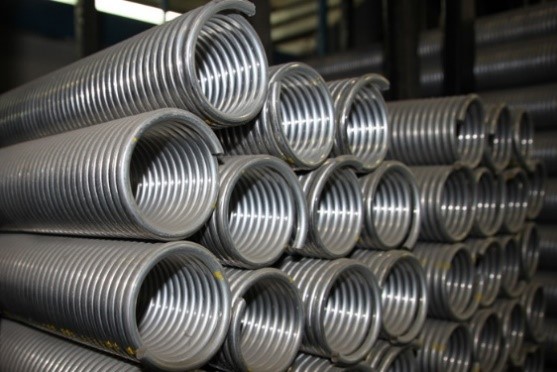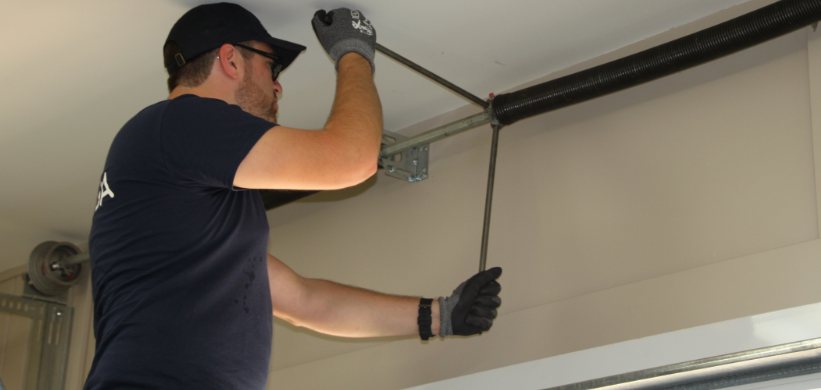If you are like most people, you probably don’t know a whole lot about the springs that make your garage door function properly. In fact, you may not even know that your garage door requires springs! There is no shame in it, of course. Garage doors may be our specialty, but we know that they aren’t exactly on the top of the list for most people.
It is good to know a little about your spring system if you are a property owner that has a garage door. This knowledge will help you keep your garage door in good repair and help you understand what to do if something was to suddenly break.

Extension vs Torsion
In the world of garage doors, there are two types of springs that you should be aware of. The first is called an extension spring and the second is called a torsion spring. We are going to break those two types down a little further so you can get a better understanding of their key differences.
Extension springs are found over the horizontal tracks, while torsion springs are found directly over the garage door. Most modern doors work on a torsion spring system for three main reason:
- They are quieter. The torsion spring is affixed to the wall over the door instead of over the tracks. This placement makes it a lot quieter when the garage door is being opened and closed.
- They are safer. A torsion spring is inserted in a shaft. So, if the spring breaks, it will stay attached to this shaft. An extension spring may or may not be affixed with a safety cable. If not, when a spring breaks, it can fly off and damage any people or property that happen to be in its path.
- They are more reliable. A torsion spring opens the door in a much smoother manner than an extension spring. Plus, they are less likely to become unbalanced. An unbalanced spring will put the door out of alignment and cause a lot of shaking and vibration while in use.
Understanding the Torsion Spring
You probably already know a thing or two about torsion springs because they are quite literally found all over the place. The spring is shaped like a coil, and it works due to the twisting or torsion. The mechanical energy is stored in the spring, and then it can easily lift the weight of the garage door whether you are doing it manually or with an electric door opener.
All the Parts Work Together
No spring is an island... or rather, no spring does all of the work of opening and closing the garage door by itself. All of the components of the door must work together correctly to get the job done.
The spring is inserted into a shaft that is mounted to the wall. The shaft is also connected to a grooved drum that has a lifting cable wrapped around it. The lifting cable is attached to the the door via a bracket. They all work together: bottom bracket + lifting cable + drum + shaft + spring. When the door is closed, it is transferring the mechanical energy to the spring, and when it is open the spring is relaxed.
So, how much does the garage door weigh? The short answer is a lot, but you can find a more specific answer below:
-
For a 1 ¾"-thick steel door, insulated with polyurethane foam: about 2 lb. per square foot (if there are windows, add the weight of each window, about 2 ½ to 3 lb. per window), meaning:
- 9 x 7 ft. = around 150 to 160 lb. (68 to 73 kg)
- 16 x 7 ft. = around 280 to 295 lb. (127 to 135 kg)
-
For a 2"-thick steel door, non-insulated: about 1 ½ lb. per square foot, meaning:
- 9 x 7 ft. = around 125 to 130 lb. (57 to 59 kg)
- 16 x 7 ft. = around 280 to 295 lb. (102 to 107 kg)
Still Have More Garage Door Questions?
You may still have a few questions about the systems and how they work. That is understandable which is why we created this little FAQ section:
-
Is the spring for a single door always installed on the left when viewed from the inside?
Not always. Different manufacturers tend to put the spring on different sides. Your door may have one on the left or the right.
-
How many springs are found on a door?
In most cases, single doors (often 9 x 7 ft.) have only one spring, and double doors (for example 16 x 7 ft.) have two of them.
-
How long does a spring last?
Garage door ratings are listed in cycles, and one cycle is the opening and closing of the door. Most springs are rated for 10,000 cycles, but really high‑end doors may be rated for 20,000‑25,000 cycles. If you use your garage door a couple of times per day, you can expect it to last about 7 years on the standard 10,000 cycles.
-
Are the garage door springs galvanized?
On average, springs contain about 35 to 40% galvanization (zinc) to protect against rust. If your garage is extremely humid, be aware that there exist fully galvanized torsion springs.
-
Is there a way to extend the life of a spring?
Doing proper routine maintenance and making sure your springs get regular lubrication will protect them against premature corrosion. Lubrication also eliminates noise when spring coils rub against each other. It is important to use a petroleum‑based lubricant and also hit up all of the other metal moving parts as well.
-
How can I tell if things are working as they should?
You have to operate your door manually. If you have an electric garage door opener, deactivate it and try to lift your door. It should only weigh between 8 to 10 lb. (3 to 5 kg), and you ought to be able to lift it with only one hand without straining yourself.
-
Is a torsion spring always placed in front?
Most of the time it will be placed in the front. However, if there isn’t enough headroom over the door (12”), then the spring will have to be mounted in the rear.
Never Attempt to Repair a Broken Spring!
Broken torsion springs can be extremely dangerous, and they should never by changed without the assistance of a trained professional. If you live in or around Fredericton, give this task to an expert and contact us now at 506‑450‑3031. We know garage door from A to Z, and we know how to handle and repair these parts under high tension. If you’d like, we can send you a repair cost quotation by email.







Add new comment